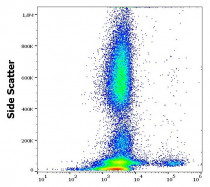ARG62775
anti-CD22 antibody [MEM-01]
anti-CD22 antibody [MEM-01] for Flow cytometry,Immunoprecipitation,Western blot and Human,Primates
Cancer antibody; Developmental Biology antibody; Immune System antibody; Immature B Cell Marker antibody
Overview
| Product Description | Mouse Monoclonal antibody [MEM-01] recognizes CD22 |
|---|---|
| Tested Reactivity | Hu, NHuPrm |
| Tested Application | FACS, IP, WB |
| Specificity | The clone MEM-01 reacts with CD22 (BL-CAM), a 130 kDa type I transmembrane glycoprotein (immunoglobulin superfamily) expressed in the cytoplasm of pro-B and pre-B lymphocytes, and on the surface of mature and activated B lymphocytes; it is lost on plasma cells, peripheral blood T lymphocytes, granulocytes and monocytes. MEM-01 cross-blocks the antibody OTH228 that recognizes uniquely epitope "E"; it does not cross-block antibodies RFB-4, CLB22/1 and CLB-BLy1. |
| Host | Mouse |
| Clonality | Monoclonal |
| Clone | MEM-01 |
| Isotype | IgG1 |
| Target Name | CD22 |
| Antigen Species | Human |
| Immunogen | Raji Burkitt's lymphoma cell line |
| Conjugation | Un-conjugated |
| Alternate Names | B-lymphocyte cell adhesion molecule; B-cell receptor CD22; T-cell surface antigen Leu-14; BL-CAM; SIGLEC-2; Sialic acid-binding Ig-like lectin 2; Siglec-2; CD antigen CD22; SIGLEC2 |
Application Instructions
| Application Suggestion |
|
||||||||
|---|---|---|---|---|---|---|---|---|---|
| Application Note | WB: Under non-reducing condition, incubate 120 min on vertical incubator; Sample preparation for WB: resuspend approx. 50 mil. cells in 1 ml cold Lysis buffer (1% laurylmaltoside in 20 mM Tris/Cl, 100 mM NaCl pH 8.2, 50 mM NaF including Protease inhibitor Cocktail). Incubate 60 min on ice. Centrifuge to remove cell debris. Mix lysate with non-reducing SDS-PAGE sample buffer. The antibody MEM-01 stains only the zone corresponding to 140 kDa, but not the weaker 130 kDa zone (stained by several CD22 antibodies recognizing both isoforms). * The dilutions indicate recommended starting dilutions and the optimal dilutions or concentrations should be determined by the scientist. |
||||||||
| Positive Control | WB: Raji, Human lymphoma cell line. |
Properties
| Form | Liquid |
|---|---|
| Purification | Purified from ascites by protein-A affinity chromatography. |
| Purity | > 95% (by SDS-PAGE) |
| Buffer | PBS (pH 7.4) and 15 mM Sodium azide |
| Preservative | 15 mM Sodium azide |
| Concentration | 1 mg/ml |
| Storage Instruction | For continuous use, store undiluted antibody at 2-8°C for up to a week. For long-term storage, aliquot and store at -20°C or below. Storage in frost free freezers is not recommended. Avoid repeated freeze/thaw cycles. Suggest spin the vial prior to opening. The antibody solution should be gently mixed before use. |
| Note | For laboratory research only, not for drug, diagnostic or other use. |
Bioinformation
| Database Links | |
|---|---|
| Gene Symbol | CD22 |
| Gene Full Name | CD22 molecule |
| Background | CD22, also known as Siglec-2 (sialic acid-binding immunoglobulin-like lectin-2) is a transmembrane glycoprotein binding alpha2,6-linked sialic acid-bearing ligands. Intracellular domain of CD22 recruits protein tyrosine phosphatase SHP-1 through the immunoreceptor tyrosine-based inhibitory motifs (ITIMs), thus setting a treshold for B cell receptor-mediated activation. CD22 also regulates B-cell response by involvement in controlling the CD19/CD21-Src-family protein tyrosine kinase amplification pathway and CD40 signaling. CD22 exhibits hallmarks of clathrin-mediated endocytic pathway. |
| Function | Mediates B-cell B-cell interactions. May be involved in the localization of B-cells in lymphoid tissues. Binds sialylated glycoproteins; one of which is CD45. Preferentially binds to alpha-2,6-linked sialic acid. The sialic acid recognition site can be masked by cis interactions with sialic acids on the same cell surface. Upon ligand induced tyrosine phosphorylation in the immune response seems to be involved in regulation of B-cell antigen receptor signaling. Plays a role in positive regulation through interaction with Src family tyrosine kinases and may also act as an inhibitory receptor by recruiting cytoplasmic phosphatases via their SH2 domains that block signal transduction through dephosphorylation of signaling molecules. [UniProt] |
| Highlight | Related Antibody Duos and Panels: ARG30308 Immature B Cell Marker Antibody Panel (CD19, CD20, CD22, IgM Fc) (FACS) Related products: CD22 antibodies; CD22 ELISA Kits; CD22 Duos / Panels; Anti-Mouse IgG secondary antibodies; |
| Research Area | Cancer antibody; Developmental Biology antibody; Immune System antibody; Immature B Cell Marker antibody |
| Calculated MW | 95 kDa |
| PTM | Phosphorylation of Tyr-762, Tyr-807 and Tyr-822 are involved in binding to SYK, GRB2 and SYK, respectively. Phosphorylation of Tyr-842 is involved in binding to SYK, PLCG2 and PIK3R1/PIK3R2. Phosphorylated on tyrosine residues by LYN. |
Images (2) Click the Picture to Zoom In
-
ARG62775 anti-CD22 antibody [MEM-01] FACS image
Flow Cytometry: Human peripheral whole blood stained with ARG62775 anti-CD22 antibody [MEM-01] at 0.6 µg/ml dilution, followed by APC-conjugated Goat anti-Mouse antibody.
-
ARG62775 anti-CD22 antibody [MEM-01] FACS image
Flow Cytometry: Separation of human CD22 positive lymphocytes (red-filled) from human CD22 negative lymphocytes (black-dashed). Human peripheral whole blood stained with ARG62775 anti-CD22 antibody [MEM-01] at 0.6 µg/ml dilution, followed by APC-conjugated Goat anti-Mouse antibody.







